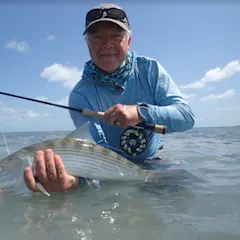I don't remember precisely when I bought my johnboat. Before the kids were born, certainly. Before my first dog. But after I married Julie, which was in 1991, and this I know because instead of spending the money I had laboriously saved for several years to buy a boat, I purchased an engagement ring. It sported a central solitaire flanked by two smaller diamonds. To this day, she calls it “Eddie’s boat, motor, and trailer.” To this day, I don’t think that’s funny.
But once I did buy my johnboat—a 16-foot double-wide Lowe hull with a 25-hp Mercury motor—there was no looking back. I don’t think I’ll part with it. Although I came close.
Damnation, what freedom seems to attend such a simple, straightforward craft. There is something about the sound of water on an aluminum hull—yes, I know it spooks fish, but it also seems to thrum with all of the unseen life below. You can feel each ripple in the water underfoot. Driving it with a tiller-handle outboard reminds me of blasting down a childhood hill in a go-cart hammered together of spare wood and old lawnmower axles. It is primal. Elemental. Foundational.
And now, some 30 years after I brought her home, I’m realizing what a life she’s had—and allowed me to have, chapter by chapter, each one unlike any of the others.
Little Big Boat
The boat was first pressed into service as a duck boat, not to hunt from, necessarily, but to get my pal Lee Davis and me far enough down rivers and up creeks that we could leave the bigger, heavier boats behind. We’ve hunted waters so skinny we had to push the johnboat by hand, and coastal waters so wide and gnarly the slop came over the bow in great drenching waves.
Next, I rigged the boat for the famed runs of shad and striped bass on the Roanoke River, in my home state of North Carolina. I jerry-rigged fly rod holders with PVC pipe and employed cinder blocks as river anchors, because we knew we’d lose them in the craggy bottoms of the Roanoke.
And then there was a dark decade in our relationship. If aluminum had a heart and soul, I would apologize profoundly. At some point, dealing with the boat became a hassle. I’d bought a bigger boat and was running ocean waters more often than rivers and creeks. I drained the gas from the outboard motor, greased up everything I could grease on the boat, motor, and trailer, and backed the johnboat into an old hog farrowing barn on my deer lease. It sat there, year after year, like a giant metal storage bin filled with deer stands and deer carts, its trailer tires dry-rotting away.
I pulled the boat out of storage when my son, Jack, was old enough to handle it by himself. We’d fallen into a small house at the coast, and he had big dreams of side money as a crabber. That lasted a few years, until he was old enough to handle our center console by himself. A 15-year-old kid is going to go for the 150 horses over 25 every day of the week.
Then, one of the saddest chapters in the life of that old boat—sadder, perhaps, than being stuffed in a wasp-filled hog barn: During a hurricane, the johnboat filled with water and the weight smashed the springs and bunks of one side of the trailer. It then sat in our side yard for three full years, listing to one side, sprouting weeds, aggravating the neighbors.
“When are you going to do something with that old boat?” Julie asked, frequently. “If you’re going to leave it in the yard, maybe you should put an old sofa or washing machine in it. At least that would complete the look.”

A good day on the johnboat during the spring striper run. (Photo: T. Edward Nickens)
Often, I was on the verge of selling the johnboat. It did look pretty janky out there by the street. But I couldn’t let go of my memories of all the places it had taken me. And I couldn’t let go of thinking that one day I would fix it up, return to all those places, and make a few more memories.
As Good As Ever
Happily, these are glory days once again for that old soldier. I recently put in a no-skid floor and decked the seats and bow deck with marine plywood. (And I did this all by myself, which required four and a half weeks of trial-and-error carpentry and a dozen trips to Home Depot.) I repowered the ship with a Yamaha 4-stroke, with one of the glorious inventions of maritime history: electric start. It’s still a stripped-down kicker. Tiller handle. Manual tilt. No jack plate. But a man’s shoulder can only take so much of a rope-pull start, and mine had notched too many pulls already.
And this time of year, my old john is back into heavy-duty use. The shad are in the rivers, and the stripers aren’t far behind. They’ve been there all along, of course, along with the shadbush blooms and the prothonotary warblers flitting streamside and the turkey gobbles that echo across the wide, boulder-strewn river. It was me that left. And every time I shove that boat back into the river’s flow, I know I won’t ever leave again.
Gear Tip: Secret Weapon for the Johnboat

Chico Fernandez calls Hardy’s Zane fly rod in a shortened 8-foot 8-weight his “sawed-off shotgun,” and I recently watched him fire off quick, tight loops as we prospected the Indian River shoreline in Florida. Load that diminutive length with a short head fly line like a Rio Outbound and casting heavy or large flies becomes much easier. The rod is also superfast to deploy, slipping out of under-the-gunwale rod holders with ease. The rods comes in a standard 9-foot length as well, in line sizes from 6 to 8.






